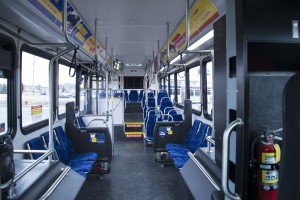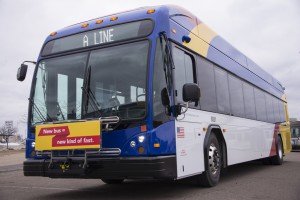By TESHA M. CHRISTENSEN
On June 11, locals will have a new transportation option.
The Bus Rapid Transit (BRT) A Line will begin operating locally from Rosedale Mall, down the busy Snelling Ave. commercial corridor to Highland Village and over to 46th St. Station in Minneapolis.
The A Line will offer a new kind of bus service that will cut the journey from 46th St. station to Rosedale Mall from 48 minutes to 35 minutes.
The line officially opens at 10am.
Bus service on the A Line and Route 84 will be free June 11 to 13.
 Photo right: The 40-foot Gillig model buses look significantly different than regular-route buses. Passengers will be able to get on and off faster, thanks to low-floor buses and raised curbs at stations, plus wider bus doors and boarding from the front and back. (Photos submitted)
Photo right: The 40-foot Gillig model buses look significantly different than regular-route buses. Passengers will be able to get on and off faster, thanks to low-floor buses and raised curbs at stations, plus wider bus doors and boarding from the front and back. (Photos submitted)
Midway resident Jessica Treat of Transit for Livable Communities is looking forward to the start of the A Line. “It’s a significant change and the first in the region,” pointed out Treat.
Como resident João Medeiros said, “I am excited that the BRT will provide an efficient connection from my side of the neighborhood to the Green Line, which should provide easy transit access from the neighborhood to both downtown Minneapolis and downtown St. Paul.”
 Mederios is looking forward to seeing whether the BRT helps alleviate some of the congestion at State Fair time. “As an all-season user of the Como and Snelling bus stop, I am also excited that the stations are going to have radiant heating in the winter, like light rail stations,” he added.
Mederios is looking forward to seeing whether the BRT helps alleviate some of the congestion at State Fair time. “As an all-season user of the Como and Snelling bus stop, I am also excited that the stations are going to have radiant heating in the winter, like light rail stations,” he added.
Opening day events
Events planned from 10am to 2pm on June 11 include:
• Snelling and University: Official ribbon cutting ceremony begins at 9:30am with the ribbon cutting at 9:50. There will be live music and food trucks. Community groups and businesses will have tables set up.
• HarMar Mall: The first bus will bring the mayor of Roseville to HarMar at about 10:10am, where there will be a short ceremony and music by the Roseville City Band and other groups.
• Highland Park: The event will take place at Hillcrest Park, located at Ford Pkwy. and Kenneth, an A Line stop. Community groups, local businesses, and the park board are coming together to host an event celebrating the launch of the A Line route. There will be a climbing wall and children’s craft activity.
• 46th Street Station: A Line bus on display and Metro Transit personnel available to answer questions.
Cross between bus and train
Bus Rapid Transit makes riding a bus a bit more like riding a light rail train.
Customers will pay their fares at ticket vending machines before boarding the bus.
By extending the curbs at stations, buses can merge more easily into traffic after serving a station. The buses won’t pull over to board passengers, but will instead remain in the right driving lane.
Each A Line station is comprised of a northbound and southbound platform. All station platforms will have a customer waiting shelter with interior light and heater, as well as a pylon marker with a real-time NexTrip display.
Passengers will be able to get on and off faster, thanks to low-floor buses and raised curbs at stations, plus wider bus doors and boarding from the front and back. These 40-foot Gillig model buses will look significantly different than regular-route buses.
The A Line buses will stop at fewer red lights courtesy of transit signal priority, and stay better in sync with traffic flow.
While people typically think that traffic is the main reason for bus delays, a traffic analysis showed that delays actually occur from stopping every block, customers paying fares, and stopping at red lights.
BRT addresses these issues.
21 stations every one-half mile
The A Line will connect the Twin Cities’ two metro light-rail lines with the busy Snelling Ave. commercial corridor and several popular destinations, including Hamline University, Macalester College, Midway, Highland Village, Minnehaha Park, Rosedale Center, and HarMar Mall.
The A Line will operate every 10 minutes along the 9.7-mile-long route during rush hours, midday, evenings, and weekends, with less frequent service in the early morning and late at night. The span of service is very similar to today’s Route 84 schedule, with trips beginning at approximately 4am and continuing until approximately 1:30am.
Twenty-one stations are located roughly every half-mile.
The A Line will become the primary bus route serving Snelling Ave. and Ford Pkwy. with increased service in evenings and on weekends, substantially replacing much of Route 84.
Local Route 84 will operate every 30 minutes and make off-corridor branch connections to St. Paul Ave., West 7th St. and Davern St.
Transferring between the A Line and light rail is easy. No matter where you purchase your ticket, it will be valid for 20 hours of unlimited rides. Additionally, A Line tickets are valid for regular-route buses; present your ticket to the driver but don’t insert it into the fare box so that you can keep using it.
Are people riding for free?
Some residents are concerned that riders aren’t paying for their light rail trips and won’t pay for the A Line ride either.
For Hamline Midway resident Dave Olson, not paying for a ride is theft.
“I take the Green Line fairly often and while waiting for trains observe how many just walk past the payment machines and get on the train. Am I an idiot for not riding free also?” asked Olson.
The issues for Hamline Midway resident Tom Goldstein are the $180 fine people are charged if caught riding without a ticket and the use of police officers rather than train monitors for the fare checks. “I wish that everyone were honest—or had the means to pay for transit—but I’d rather see our focus be on keeping the trains safe for all riders than creating a system with out-of-whack penalties and out-of-whack priorities for how we do enforcement,” remarked Goldstein.
“Some of us will perceive rampant fare-theft and some of us will observe near universal compliance in the same train ride. Thankfully the Met Council undertook a controlled study with sound statistical methods to determine an estimate of compliance,” pointed out Hamline-Midway resident Bryan Kennedy.
According to the April 2015 report, the Blue Line fare evasion rate is between 2.6% and 3.6%, and the compliance rate is estimated to be between 80.8% and 84.8%. The Green Line fare evasion rate is between 4.6% and 9.0% and the compliance rate for is between 81.6% and 87.6%. The audit found that Go-To Card users were the largest group of people not to comply, perhaps because of a misunderstanding of how the card works. Data was collected in 2014.
Neighborhood resident and transportation researcher Guillermo Narvaez thinks that the BRT model seems well suited at this time for Snelling. However, he pointed out that “while it does increase the amount of passengers it can carry, it does not really inspire developers in the same way more permanent forms of transit does.”
BRT is attractive because the overall project costs less, but it is less effective in moving people than a light rail or metro system, he noted. “The idea is one that the GOP will tolerate (versus light rail or streetcar) as it shares the same road infrastructure that cars and trucks use,” Narvaez said.
Why the Snelling Ave. route?
In 2011, Met Transit studied 12 high-ridership corridors and determined that BRT would perform well along the Snelling/Ford/46th route. As a bonus, it was shovel-ready.
The other routes included in the Arterial Transitway Corridors Study were: Lake St., American Blvd., Central Ave., Chicago Ave., E. 7th St, Hennepin Ave., Nicollet Ave., Robert St., Snelling Ave., West 7th St. and West Broadway Ave. The study later added Penn Ave. and Chicago-Fremont in North Minneapolis.
Construction on the line began in 2015 with road improvements, new shelters, and other amenities. The line was originally slated to open in 2015, but a lengthy review period set the project back.
The total cost of the A Line project is about $27 million, with money coming from the federal government ($7 million), the state of Minnesota ($16 million) and the Metropolitan Council ($4 million). Of that, $15 million was spent constructing stations and adding related technology and fare collection elements; $7 million on new BRT vehicles for the service; $1 million on transit signal priority; and $4 million on design.
Plans call for 20 rapid transitways by the year 2040—16 to 17 of those would be BRT lines. This system will allow another 500,000 people to be a 30-minute commute from their workplace.
“I believe in transit and other forms of transportation that make cities more livable and attractive,” said Narvaez. “Is the BRT a perfect solution? Hardly, but it has us talking and thinking about it instead of just driving through places that hopefully will become destinations in the near future.”
Comments
No comments on this item Please log in to comment by clicking here